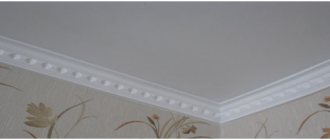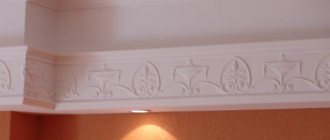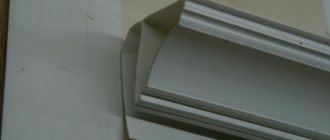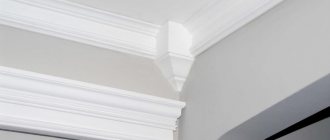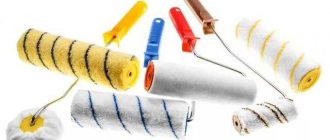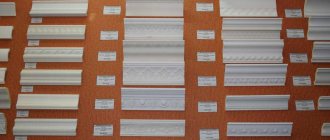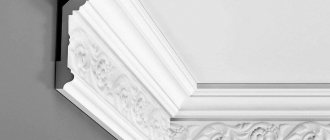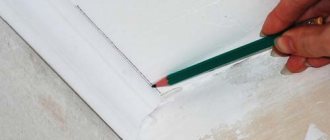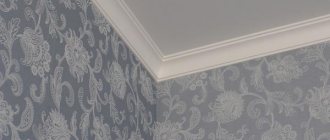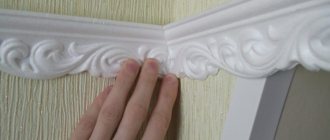Ceiling plinth is an excellent decorative element that allows you to eliminate defects that exist between the wall and ceiling and decorate the room. When installing such a plank, the ceiling takes on a complete look. Today there are a large number of options for ceiling plinths, one of which is sure to suit the decor of your room.
Types of skirting boards for ceilings
Materials used for manufacturing.
| Skirting | Description | Photo |
| Polyurethane. | Durable, elastic, bends well and is suitable for decorating even rounded surfaces. It successfully replicates stucco molding, complex ornaments and patterns, and is suitable for painting with any paints. | |
| Wood. | Made from various types of wood. Such ceiling moldings look very expensive and add aristocracy to the interior. | |
| Made from polystyrene foam. | It is characterized by low price and easy installation. The only negative is that it is very fragile and does not bend at all. | |
| PVC (polyvinyl chloride). | Durable, easy to maintain and install. Such models are easy to cut, fit perfectly and can be painted multiple times in different colors. | |
| Polystyrene. | Extruded polystyrene plinth fits perfectly to the wall and ceiling. It washes well and is also easy to paint. | |
| Duropolymer. | Eco-friendly, hard material, resistant to mechanical stress and perfect for rooms with high humidity. | |
| Plaster. | It has an exclusive, aesthetic and rich look. Gypsum models are very reliable, environmentally friendly and fire resistant. |
Wooden – originality and comfort
Nowadays you won’t surprise anyone with an elegant white frieze, but wooden panels can create an original interior. Its distinctive feature is contrast through the use of rich stains. Usually pine is used to make it, then it is additionally veneered with beautiful wood species. More expensive models are made of oak, maple and other noble species.
Rich wood shades will help to interestingly outline the perimeter of the ceiling in a classic and English style, introducing solidity and aristocracy. It is also suitable if you are decorating the interior in Provence style, adding romance, originality and good quality.
This baguette is not particularly flexible, but it does have a bonus - some models have grooves for wiring. This way you can hide the wires or arrange interesting lighting.
Varieties of skirting board textures
The main types that are classified according to texture parameters:
- Smooth. It has a flat, smooth surface, without indentations, patterns or ornaments. It looks discreet and is great for decorating almost any interior.
- Extruded. It is distinguished by longitudinal recesses with ready-made grooves.
- Injection. It has a convex relief surface and has a granular structure. Such ceiling fillets are an independent decoration.
The photo shows an injection ceiling fillet in a beige shade.
What sizes are there?
There are two main types: wide and narrow. Other tips for choosing the size will be listed below.
Narrow
Size range from 10 to 50 mm. Thin, laconic fillets are suitable for small rooms with low ceilings.
Wide
Allows you to visually smooth out corners and hide imperfections and unevenness of the walls. It has a range from 160 to 350 mm, and is most often used for decorating spacious rooms.
Varieties of fillet shapes
There are several types:
- Straight. The traditional and most common option, which is found in almost any interior.
- Flexible (soft). Such radius baguettes allow you to organize smooth shapes, thereby hiding imperfections, crooked corners and flaws in the ceiling space.
- With cable channel. They have additional internal space in which you can hide wires.
Each of the listed forms carries a certain focus and functionality.
Product width
You also need to pay attention to such a parameter as the width of the molding.
The following recommendations are valid here:
- The smoother the walls, the narrower the ceiling plinth can be. A wide fillet perfectly masks defects in corners, and therefore such products are often installed in those apartments of old construction in which the owners were unable to “remove” the initially crooked walls with plaster.
The wide model hides defects well
- A narrow ceiling plinth, on the contrary, will emphasize any curvature of the walls. On the other hand, a narrow edging will make it possible to make the room more expressive, especially if the fillet is chosen with a contrasting shade.
- Medium-width panels (ceiling plinth 35 by 35 mm or more) will be appropriate in almost any room, excluding large halls. For such details, smooth shapes are preferable, as they make the room more comfortable.
A universal solution using medium-width panels
- Finally, the widest products are suitable for large areas. If you install a 100x100 mm fillet in a small room, then it will “eat up” a significant part of the ceiling, and the room will seem more cramped than it actually is.
What color are the skirting boards?
Colored fillets change the overall perception of the interior and the room as a whole. In addition, ceiling plinths can be painted independently in any color.
- White.
- Black.
- Gold.
- Brown.
- Beige.
- Grey.
- Chromium.
- Yellow.
- Blue.
- Green.
The photo shows a narrow yellow ceiling fillet in the dining room interior.
To visually expand the space, use baguettes that match the color of the ceiling; to increase the height of the room, use ceiling plinths that match the color of the walls.
User manual
First of all, you will need the following tools: a fillet, a measuring tape or tape measure, a laser plotter, a sharp knife and a hacksaw.
Also, depending on whether the wallpaper is already glued or not, the following devices are needed: if the wallpaper is not glued - PVA glue, a container for the mixture, a spatula, water-based paint and sandpaper; if glued - acrylic sealant, installer and rags.
Cutting a corner and creating a blank
First, determine the corners in the room, and only then prepare the blanks for them (it is important to do the procedure in this order, the blanks may differ).
For external corners, the length of the workpiece must be the same size as the span length and the cutting angle must be 135°.
For internal ones it’s the same, only the cutting angle is narrower – acute at 45°.
When cutting, try to do everything carefully and smoothly, avoiding mistakes. If you doubt the correctness of the blanks, you can compare them on the floor. When the corners are evenly combined, you can start gluing.
If the corners do not meet, do the workpiece again. To avoid a situation where there are not enough materials, purchase a little more fillets.
Gluing process
Some experts do not recommend gluing ceiling plinths to wallpaper, but this does not mean that it is prohibited. It is enough to observe several compatibility factors: interior, surface evenness, etc. The essence of gluing a cornice is that the product is attached to the wallpaper with glue. In this case, installation is very easy and not labor-intensive. By observing the masters in this field, you can be convinced of this.
Installation and preparation of products before gluing
The point of this method is to attach the fillet to the wall before finishing with the coating. As in the previous case, the method is used by professionals, because they solve 2 problems at once. The first problem is that the ceiling material is immediately installed, the second is that all uneven areas and cracks are puttied before gluing. This process is more complex and time-consuming than the previous one, but more effective. With a little practice, you will also be a master in this area.
Preparation consists of marking the surface. First, a simple drawing is created. So, take an A4 sheet and apply the scale according to the ratio 1 meter = 1 centimeter. The plank and perimeter of the room are drawn on the sheet. Using a “mini-room”, make sure that there is as little excess as possible, i.e. You will have to cut it to a minimum.
Design options and drawings
A huge variety of decor gives baguettes a more unique look.
- Stucco molding. Always looks expensive and respectable. It brings notes of antiquity and luxury with its appearance and is best combined with classic interiors.
- With inserts. Inserts can be made in various colors, for example white and gold or dark wenge and silver. They are selected in combination with the color of the ceiling or walls.
- Patterns and ornaments. They transform and enliven the ceiling space, deprive it of monotony and set a unified style for the room.
- Ladder. The original cross-section in the form of a ladder creates a stepped ledge, which is quite popular in the design of many interiors.
The photo shows a white wide ceiling molding in the shape of a ladder.
Baguettes with a variety of designs harmonize the decor, give the room a special character and simply look very impressive.
Styrofoam
Pros:
- Cheapness.
- Compatible with stretch ceilings.
- Little weight.
- Lots of appearance options.
- Can be painted several times.
Minuses:
- Fragility.
- Additional processing required.
- Fire hazardous.
For what types of ceilings can decorative skirting boards be used?
The main types of ceiling coverings to which fillets are applied:
- Stretch ceiling. Such a plinth not only protects and hides cracks and gaps between the walls and ceiling, but is also a rather original element of decorative finishing.
- Suspended ceiling made of plasterboard. For plasterboard two-level or multi-level structures, almost any model will be appropriate. Skirting boards made of polyurethane or polystyrene look especially natural with suspended ceilings.
- Wooden clapboard ceiling. Wooden figured and carved fillets in combination with the identical texture of the ceiling look luxurious and are in perfect harmony with each other.
- PVC panels. Plastic baguettes are better suited here, as they will noticeably highlight and emphasize the design of the entire ceiling.
- Ceiling tiles. Skirting boards will not only complete the overall design, but will also greatly simplify the gluing of ceiling tiles along the edge of the ceiling.
The photo shows a wooden openwork baguette in combination with ceiling lining.
Such models create a single composition on the ceiling and an additional geometric effect.
The photo shows a two-level plasterboard ceiling structure with polystyrene baguettes.
Polyurethane
Polyurethane tops our list because of its practicality and versatility. Polyurethane has the following qualities:
- High strength.
- Does not fade.
- Flexible, can be glued to complex shapes.
- Moisture resistant.
- You can use any adhesive to attach to the ceiling.
- Many colors and sizes.
- Can be painted.
Of the minuses:
- Heavy weight.
- Expensiveness of the material.
- Not suitable for suspended ceilings.
You can purchase polyurethane foam moldings to cover uneven areas and gaps.
Photos in the interior of the rooms
Baguettes can become an indispensable and main decoration of any room.
Bathroom
Galleys allow you to beautifully decorate your bathroom, give it the desired appearance or set the style.
Kitchen
Classic simple ceiling models made of polyurethane or polystyrene, which are resistant to high humidity and are easy to clean, would be appropriate here. It is advisable to choose wooden skirting boards for the kitchen without unnecessary patterns and ornaments.
Living room
Baguettes can completely change the interior of the living room, create unusual color and shade combinations and simply decorate the ceiling space.
The photo shows a small room with ash-colored ceiling moldings.
Balcony
To decorate a small balcony, narrow baguettes are suitable, which will visually balance and balance the narrow space.
Children's
Properly selected baseboard colors will allow you to create a harmonious design for the nursery, create smooth color transitions on the ceiling and thereby add additional height to the room.
Main types of baguette
Having decided to carry out renovations, many now turn to specialists, although there are also people who prefer to decorate their apartment themselves. Choosing a ceiling plinth for your interior is not so difficult because specialized building materials stores offer a huge selection of this decorative element.
As a rule, the types of fillets depend on the material they are made of. Naturally, their installation is also different. The following types of baguettes are distinguished:
- PVC plinth is very pliable and easy to install, which is why it is most often used in the design of ceilings. The cost of this type of baguette is low, which makes it possible to use them for budget repairs.
- Polyurethane is a current and modern look that is practical and uncomplicated in fastening. Its price is relatively high.
- Foam baguette is the cheapest option. It is flexible, plastic and easy to decorate. However, this material has some disadvantages: low wear resistance and toxicity.
- Gypsum fillet is one of the most elite and expensive types of ceiling decoration. It allows you not only to close gaps, but also to give the room luxury and individuality (photo).
- Skirting boards made of polystyrene foam are rightfully considered very practical. Its cost is not very high, however, according to technical descriptions it is in no way inferior to other types.
- Wooden fillet is distinguished by its environmental friendliness and beauty. Any wooden details are considered classics in interior design because they can transform any room and make it much more refined. You can choose a plinth from a variety of types of wood, from the most widely known (ash and pine) to exclusive (mahogany). Of course, the price of such ceiling moldings is not small, but the effect from them is always unforgettable. Such a ceiling element will look most advantageous in wooden rooms.
- Illuminated fillet is usually used for creative design projects. The plinth, which is used for lighting, is made of polyurethane, wood and plastic. This type of cornice has special grooves for fastening LED lighting. Lighting can be directed at the wall or the ceiling.
A selection of photos of skirting boards in various styles
A wide variety of models and decor allows you to choose an option for a room with any style direction.
Modern
Models of a simple shape with simple lines will look especially organic in this style. Thanks to their versatility and huge selection, they will allow you to create a stylish and modern design.
Classical
Plaster, wooden or polyurethane skirting boards with carved patterns, stucco or gilding are perfect for interiors designed in a classic style.
Loft
This style does not involve intricate decoration. Light fillets with a simple and laconic design are suitable here.
The photo shows a wide white ceiling fillet in a loft-style bedroom.
High tech
Skirting boards with clear lines and shapes, smooth, decorated with lighting, will look unusual and emphasize the futuristic and fantasy interior.
Minimalism
Thin baguettes with a discreet design, made in discreet colors, will harmoniously resonate with the rest of the minimalist decor, and will not attract unnecessary attention.
Scandinavian
White fillets without frills would be especially appropriate here, emphasizing the restraint and coldness of the Nordic style.
The photo shows a white ceiling fillet in a Scandinavian-style living room.
Gypsum
Advantages of gypsum:
- High quality.
- Environmentally friendly.
- Durability.
- Possibility to choose an individual design.
Minuses:
- Expensive.
- Heavy weight.
- Fragility during installation.
Illuminated skirting board ideas
The LED strip gives the baguettes an even more original and unique look. This lighting goes well with other lighting fixtures, such as a chandelier, sconce or spotlights.
The photo shows a children's room with a wide ceiling molding decorated with lighting.
Examples for non-standard ceilings
The functionality of skirting boards makes it possible to use them even in non-standard solutions.
Two-level
On such a ceiling, baguettes look especially beautiful. In addition, they allow you to hide transitions between levels.
The photo shows a two-level ceiling structure, decorated with wide plinths.
Sloping ceiling
Skirting boards for a sloping ceiling on the attic floor in a country house or wooden house must be flexible in order to neatly frame numerous corners in the room.
Rounded
Radius fillets are perfect for rounded ceilings. Such elastic models will easily allow you to decorate semicircular corners without unnecessary problems.
How to choose a ceiling fillet?
A few recommendations for choosing a ceiling molding:
- The fillets should preferably be combined with the color of the ceiling or walls. This way you can create a more cohesive composition.
- Wide ceiling moldings hide defects and imperfections in the room well.
- For low ceilings, you should not use bulky skirting boards, as they visually hide the height of the room.
Table of correspondence between room size and baseboard width
Correct size ratio.
| Room height | Recommended skirting board width |
| Less than 2.5 m | Up to 40 mm |
| 2.5 - 3 m | No wider than 70 mm |
| More than 3 m | 80 mm or more |
| Narrow and high rooms | 70 mm + molding |
Installation of baseboard moldings on a ceiling base
Installing skirting boards on the ceiling is a responsible operation, an error in which can result in loss of the effect of finishing the room as a whole, since the ceiling is more open to view than the floor.
Therefore, when installing fillets, all of the following components of this procedure are equally important:
- marking the base;
- cutting skirting boards into fragments;
- fastening moldings to the base;
- sealing joints between fragments;
- painting the mounted contour.
There is no universal technology for installing skirting boards on the ceiling, since the installation method depends on a number of factors, including:
- method of finishing the ceiling base;
- molding material;
- fillet designs;
- design functionality of the plinth contour.
One of the components of laying ceiling plinths is cutting fillets to size, taking into account the angle of joining of adjacent fragments, regardless of the material of the products and can be considered as common for installing all types of moldings.
